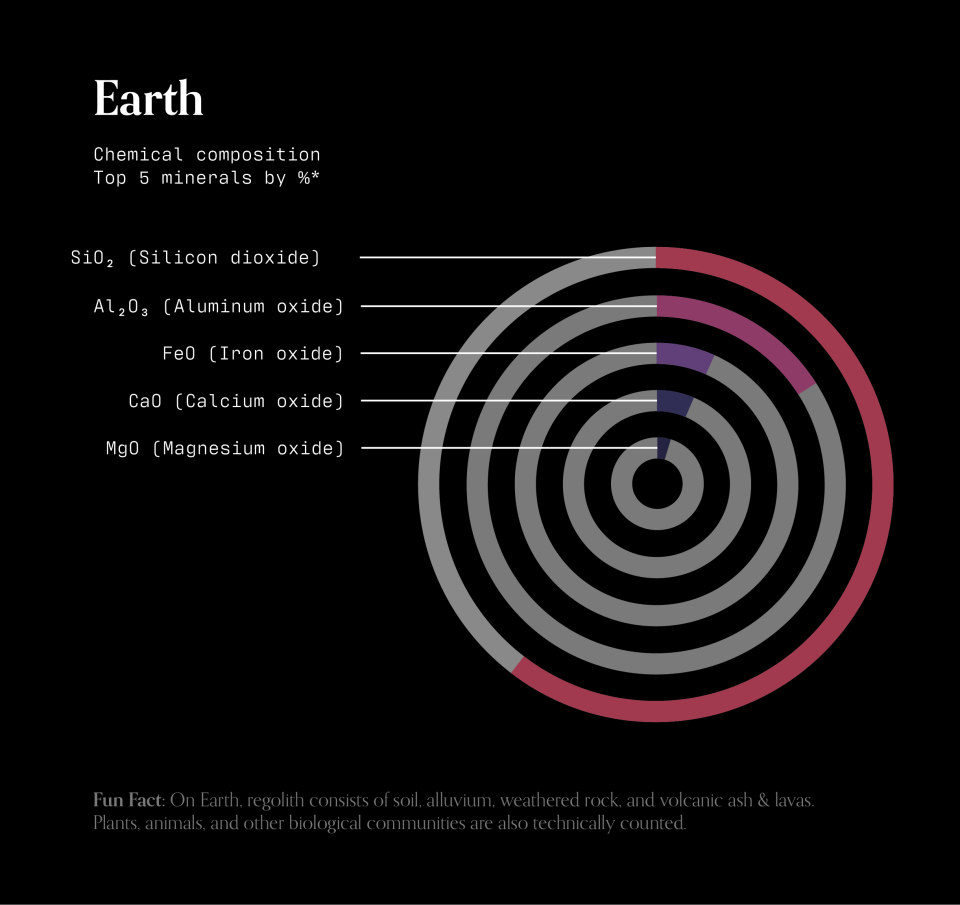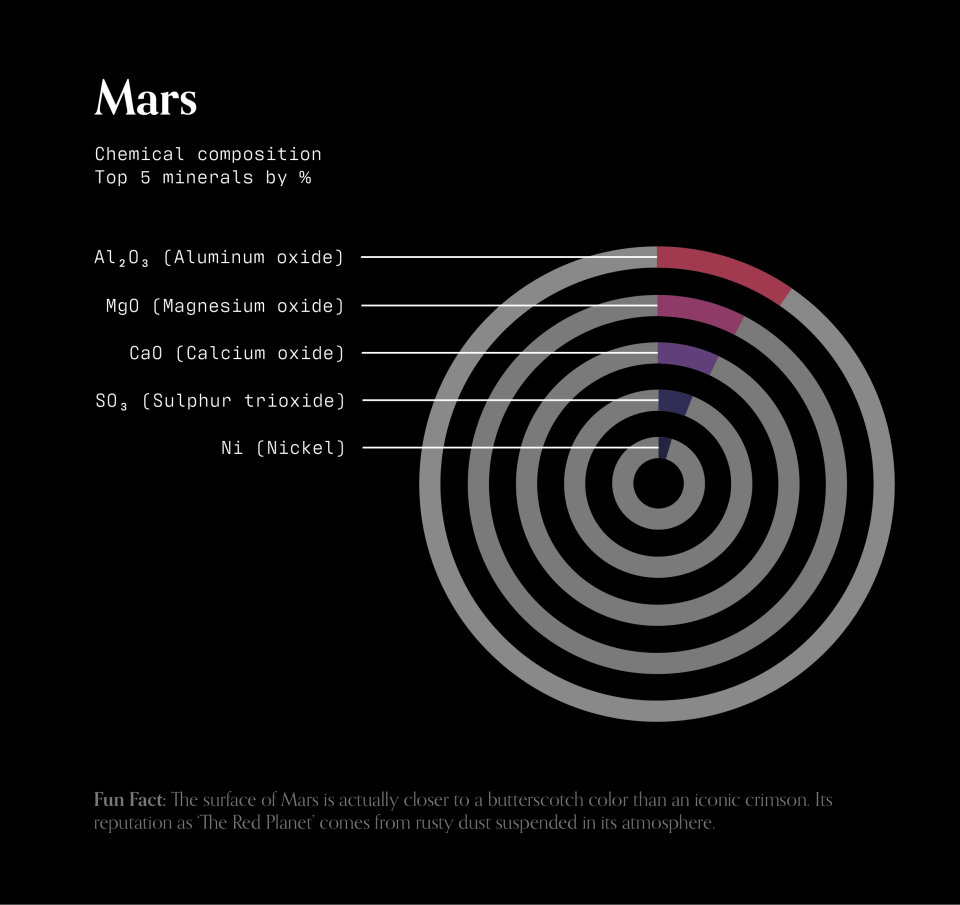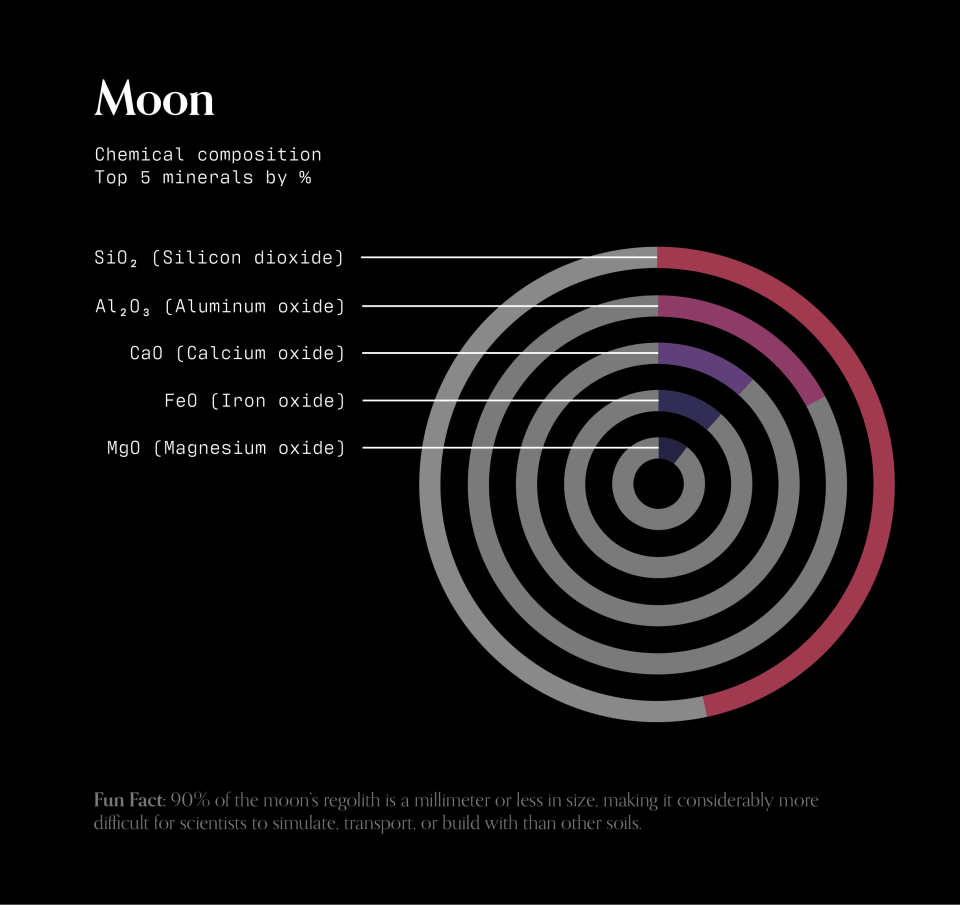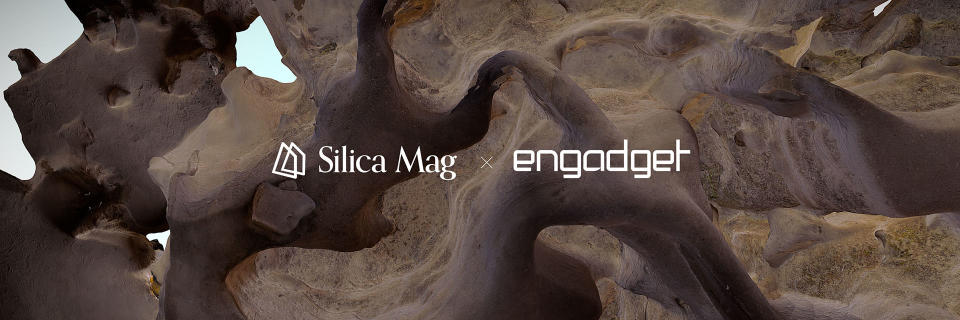Earth’s first off-world colonies will be built on soil
Regolith cities.
As Apollo astronauts trundled and trod awkwardly across the desolate lunar landscape, an insidious menace scuffed up their spacesuits. Moondust. Fine as talcum powder, sharp as glass and seemingly everywhere, these super-fine particles coated the astronauts like soot and permeated their crew cabin, where it became more than a mere nuisance. Not only did it interfere with their equipment, it irritated their nostrils and eyes, giving some a mild allergic reaction.
Nevertheless, between 1969 and 1972, Apollo astronauts brought back nearly 385 kilograms of lunar rock, pebbles and powder back to earth. Moondust deserved further study.
Today, NASA deems interplanetary dust and dirt — also known as regolith — one of the greatest risks to long-term space settlements. On Mars, it’s toxic and magnetic. On the Moon, it wears away at multi-million-dollar instruments and lodges into the slightest crevasses, weakening seals on pressure suits and causing hardware to malfunction. But for all its difficulties, regolith holds astronomical potential, too. It’s considered key to sustainable space exploration and will likely form the foundation — and the roofs, walls and infrastructure––of society's first off-Earth settlements.
The reason we'd use regolith is simple: Escaping Earth’s gravity is expensive. The heavier the payload, the more rocket fuel is needed to propel a spacecraft past the planet’s gravitational pull — and the higher the mission’s price tag. Until there’s an economical alternative to the toxic and costly rocket propellants used today, fuel costs will inhibit the launch of astronauts who insist on carrying everything they’ll ever need in the capsule alongside them.
Instead, they’ll have to be resourceful. Rather than transporting hand tools and habitats, crews will be expected to make them along the way. As many space exploration experts predict, in situ resource utilization, the practice of “living off the land” and harnessing local resources for long-term exploration, has become fundamental to humanity’s future in space. And few resources will be as accessible as regolith.

“Regolith is almost ubiquitous on planets,” says Phillip Metzger, a planetary scientist with the Florida Space Institute at the University of Central Florida. According to Metzger, who spent more than 30 years as a physicist and engineer focused on space exploration at NASA, regolith is abundant on asteroids and moons as well, formed from meteoroid impacts over billions of years. “Wherever there are planets, there is always leftover material from small bodies that bombard those planets and break up the surface material to create regolith.”
Far from some alien substance, regolith also exists all over Earth, though it goes by more familiar names — dirt, dust, soil, sand. Elsewhere, however, “regolith is basically just moon dirt or Mars dirt,” says Jennifer Edmundson, a geologist and in-space manufacturing engineer at Jacobs Space Exploration Group, a NASA contractor. Just as humans have used dirt to build shelters on Earth for tens of thousands of years, experts say space colonists will have to turn to regolith to avoid the dangers of extraterrestrial exposure, from fatal levels of solar radiation to cosmic thermal swings and micrometeoroids.

A Shire on Mars
As the clock wound down on NASA’s 3D-Printed Habitat Challenge last May, the fate of AI SpaceFactory, a leading firm for multi-planetary architecture, fell in the hands of a lanky industrial robot. After four years and a few elimination rounds, the New York-based team was head-to-head with researchers from Pennsylvania State University, vying for a top prize of $500,000 and a chance to inspire future Martian settlements.
Nearly ten hours into the last day of competition, hundreds watched as AI Spacefactory's robotic arm dangled a circular skylight over a mud-colored, vase-like structure, lowering it slowly as if placing the roof on a house of cards. For a few seconds, the skylight seemed secure. Observers began to cheer. Then, with little warning, the skylight slipped and fell through an opening in the roof, crashing to the floor with a hollow thud.
Such a mishap would be devastating for a mission on Mars. But AI SpaceFactory’s 3D-printed structure, Marsha, still impressed the NASA judges enough to earn the top prize. The firm now hopes Marsha will serve as a prototype for the first human habitats on the Red Planet.
Designed like an egg, Marsha’s form is both aesthetically svelte and extraterrestrially efficient. “On Mars the exterior air is very thin, just one percent of the Earth’s atmosphere,” explains David Malott, CEO and co-founder of AI SpaceFactory, who oversaw the building's design. As a result, Marsha would have to be pressurized on the inside to match Earth’s atmosphere; this pressure difference would cause the structure to want to pop like a balloon. The egg shape, says Malott, is meant to help keep the building from exploding.
Inside, Marsha's amenities wouldn’t be much different from those inside a small townhouse, with a few sciencey exceptions. The habitat features four floors, including a kitchen, exercise room, sleep pods and a garden where astronauts might grow herbs and leafy greens. A wet and dry lab offers space for experimentation, while a docking port on the ground floor provides easy access to a rover. The structure’s outer layer of basalt fiber, to be sourced from Martian regolith or bioplastic recycled from astronaut trash, would be designed to protect inhabitants from cosmic rays and micrometeoroids. Save a rusty dust storm, astronauts may actually forget they’re on the Red Planet.
But not all proposed Martian habitats share Marsha’s sleek design. Some resemble ant hills more than eggs and employ cruder methods than 3D printing to make use of Martian materials.
“Many of the concepts I’ve seen look like mounds of regolith piled on top of habitats,” says Metzger, our planetary science expert from before. For example, inflatable modules would be used as the habitat’s inner core, connected by a series of tubes that would serve as tunnels between main chambers. From above, the product would “look like curvy structures,” says Metzger, “like something out of The Hobbit.”

Each design method — printing and piling — has its own list of merits and setbacks. While piling regolith may be quicker and less prone to printer error, it would still require humans to ship the inflatable inner habitats, which would come at a cost. Piled regolith would also have to be secured in some way, perhaps through microwaving, compacting, or the addition of polymers. For Edmundson, piling is a temporary solution. “Once we get into the sustainability portion of exploration, we’re going to need to start building our own habitats,” she says.
3D printing offers more of the in-situ experience, but it can be resource intensive. What's more, 3D printing requires a precise mixture of specific elements, which will have to be as close as possible in composition to the simulated regolith used in experiments on Earth. There’s little margin for error when you’re millions of miles away, and regolith minerality varies depending on its source.
Research with regolith simulants is vital for the safety of future missions, says Edmundson. “That's part of the reason why I think I have job security. People are going to have to know what the differences are between the planet’s surface itself and the simulants they're using [on Earth].” Today there are about 10 Martian regolith simulants and a few dozen simulants for the Moon. “But that number is probably going to change pretty quickly,” she adds, “now that we're planning to go back.”

Suburbs of the Earth
In March of last year, Vice President Mike Pence took the stage at the National Space Council in Huntsville, Alabama and told attendees that America’s current lunar ambitions were “just not good enough.” Instead of racing toward a 2028 deadline, the agency was instructed to put boots on the Moon by 2024, with the goal of establishing a sustainable human settlement on the lunar south pole.
The ambitious new deadline left some NASA administrators scrambling––not just to ready the astronauts but also the robots that would pave the way for the crew’s arrival. For both safety and sustainability reasons, robots will be the true pioneers of our first lunar and Martian colonies, helping us find suitable locations, scout for resources and build the settlements we may one day call home.
“Construction on Earth is kind of a dangerous job,” says David Malott, of AI SpaceFactory. “Put it in the context of space and it’s exponentially more dangerous.”
As an alternative to our science-fiction fantasy of astronauts building houses on the moon, Malott describes a scenario in which teams of robots visit ahead of the astronauts’ arrival to identify sites that have easy access to desirable resources.“You’ll need to be in proximity to some valuable resource,” he explains. One of the most important resources will be water ice, which scientists think exists in large pockets on both the Moon and Mars. Beyond quenching thirst for astronauts and watering crops, H2O molecules can be split to form rocket fuel, helping propel future missions further into space.

Once the site is determined, robotic excavators will then need to begin building infrastructure. NASA’s RASSOR (Regolith Advanced Surface Systems Operations Robot) may be among the first to excavate the lunar surface. Designed to dig in reduced gravity, RASSOR's cylindrical bucket drums use serrated teeth and staggered scoops to gather, store and dump regolith for future building.
Establishing infrastructure will likely be the robots’ first task, according to Metzger, as roads and landing pads will enable astronauts to touch down and travel safely. Habitats will come later. Just don’t expect elaborate designs. “When we start doing these activities on the surface of a planet, we don't have the benefit of Earth's entire industrial supply chain,” Metzger said. “Everything we do has to use very simple methods that won’t require a lot of complexity in the early stages.”

Whether or not humanity reaches those early stages of multi-planetary colonization is yet to be determined. At least for now, the risks posed by regolith prevent our long-term habitation. Experts still aren’t sure how they'll deal with the mysterious dirt on the Moon and Mars, so while some researchers try to make use of regolith by fashioning it into infrastructure, others attempt to find solutions for overcoming the substance. To that end, NASA last year selected nine institutions to study regolith samples left untouched since the Apollo missions. Our outer space ambitions may depend on what they discover.
In the 1950s, more than a decade before humans stepped onto the Moon, British science-fiction writer Arthur C. Clarke predicted how a lunar colony might look, describing igloo-shaped inflatable habitats covered in regolith, blown up like balloons containing Earth-like atmosphere. Clarke’s prescient vision isn’t far from some of today’s leading ideas — cities built from dirt, reaching for the stars.
"We can be sure that those who come after us will think of much better ways of doing these things and will wonder at our conservatism and our quaint, old-fashioned ideas,” Clarke wrote in his 1954 book, "The Exploration of the Moon," musing on our extraterrestrial future. “And they in their turn will be laughed at by those who come after them, when the Moon is only a suburb of the Earth, and the real frontier is far away among the planets."
Artwork by Jubilee for Silica Magazine.

The Dirt Issue
Right now, as we all look out on the world through LED screens, fiber optic networks and glass-paneled windows, the physical earth seems like a distant, intangible abstraction, full of anxiety-inducing news breaks and existential threats. Here, at this strange juncture in our planet's history, we’d like to tell a different kind of story. Not one of fear, death and isolation, but of hope, life and discovery.
Take a moment to visualize where you are... the artificial materials that make up your current environment. From the concrete that covers our homes and cities to the emergency groceries we carry, to the manicured lawns that yawn across our sleepy suburbias, this issue’s hero is all around you, beneath you, within you –– working, building, disintegrating and teeming with unknown complexities.
Welcome to the Dirt Issue.
As Silica Mag’s fourth annual issue, Dirt sets out to explore the ecological, geological and anthropological systems at work beneath our feet. In our collective state of suspended isolation, we’ll take time to dig deep into the vanguard of soil science, land management and fascinating subterranean systems, unearthing some of the Anthropocene’s dirtiest dirt-related secrets along the way.
Engadget will be exclusively publishing six features from Dirt this week, Monday through Saturday. To explore the rest of the issue, head to Silica Magazine.
Monday: How to reverse-engineer a rainforest

Tuesday: Toxic coast

Wednesday: Indonesia's fight to save its most important soil

Thursday: Permafrost slump

Friday: On Russian terraforming

Saturday: Earth’s first off-world colonies will be built on soil

